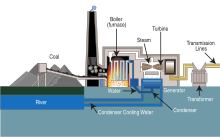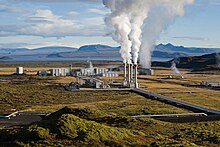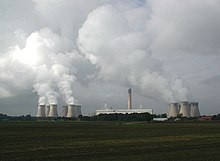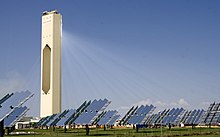
Back محطة حرارية Arabic İstilik elektrik stansiyası Azerbaijani ایستیلیک الکتریک مرکزی AZB Цеплавая электрычная станцыя Byelorussian Цеплавая электрычная станцыя BE-X-OLD Топлоелектрическа централа Bulgarian Termoelektrana BS Central tèrmica Catalan ھێزگەی گەرمایی CKB Tepelná elektrárna Czech






A thermal power station, also known as a thermal power plant, is a type of power station in which the heat energy generated from various fuel sources (e.g., coal, natural gas, nuclear fuel, etc.) is converted to electrical energy.[1] The heat from the source is converted into mechanical energy using a thermodynamic power cycle (such as a Diesel cycle, Rankine cycle, Brayton cycle, etc.). The most common cycle involves a working fluid (often water) heated and boiled under high pressure in a pressure vessel to produce high-pressure steam. This high pressure-steam is then directed to a turbine, where it rotates the turbine's blades. The rotating turbine is mechanically connected to an electric generator which converts rotary motion into electricity. Fuels such as natural gas or oil can also be burnt directly in gas turbines (internal combustion), skipping the steam generation step. These plants can be of the open cycle or the more efficient combined cycle type.
The majority of the world's thermal power stations are driven by steam turbines, gas turbines, or a combination of the two. The efficiency of a thermal power station is determined by how effectively it converts heat energy into electrical energy, specifically the ratio of saleable electricity to the heating value of the fuel used. Different thermodynamic cycles have varying efficiencies, with the Rankine cycle generally being more efficient than the Otto or Diesel cycles.[1] In the Rankine cycle, the low-pressure exhaust from the turbine enters a steam condenser where it is cooled to produce hot condensate which is recycled to the heating process to generate even more high pressure steam.
The design of thermal power stations depends on the intended energy source. In addition to fossil and nuclear fuel, some stations use geothermal power, solar energy, biofuels, and waste incineration. Certain thermal power stations are also designed to produce heat for industrial purposes, provide district heating, or desalinate water, in addition to generating electrical power. Emerging technologies such as supercritical and ultra-supercritical thermal power stations operate at higher temperatures and pressures for increased efficiency and reduced emissions. Cogeneration or CHP (Combined Heat and Power) technology, the simultaneous production of electricity and useful heat from the same fuel source, improves the overall efficiency by using waste heat for heating purposes. Older, less efficient thermal power stations are being decommissioned or adapted to use cleaner and renewable energy sources.
Thermal power stations produce 70% of the world's electricity.[2] They often provide reliable, stable, and continuous baseload power supply essential for economic growth. They ensure energy security by maintaining grid stability, especially in regions where they complement intermittent renewable energy sourcesdependent on weather conditions. The operation of thermal power stations contributes to the local economy by creating jobs in construction, maintenance, and fuel extraction industries. On the other hand, burning of fossil fuels releases greenhouse gases (contributing to climate change) and air pollutants such as sulfur oxides and nitrogen oxides (leading to acid rain and respiratory diseases). Advances in carbon capture and storage (CCS) technology could mitigate some of the environmental impacts of fossil-fuel-based thermal power stations. Government regulations and international agreements are being enforced to reduce harmful emissions and promote cleaner power generation.
- ^ a b Manoj Kumar Gupta (2012), "Thermal Power Plant", Power Plant Engineering, PHI Learning Pvt. Ltd., p. 13
- ^ Cutler Cleveland (24 July 2023). "Power plant efficiency since 1900". Visualizing Energy. Boston University Institute for Global Sustainability. Retrieved 23 August 2023.